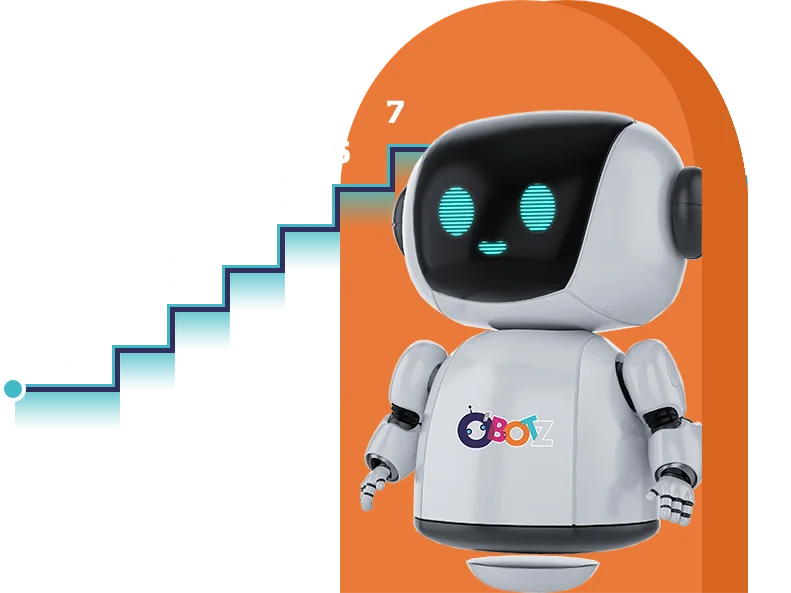
Got a question? Get your answer here.
It is a multi-disciplinary robotics program with a specially designed curriculum to teach young children about robotics. The program utilizes hands-on activities to engage a child's curious mind. Children learn to experiment, innovate and build robotic models and machines throughout the 7 progressive levels of the course.
The duration of the course is:
3 months each for Level 1 to 3
4 months each for Level 4 to 7
The children will learn the fundamental concepts of STEM by doing hands-on activities and creating projects based on real life applications. They will also develop their soft skills by solving worksheets, presentations and doing research work.
Children come in once a week for 2 hours
This program will promote all-round development in your child by engaging them in different activities like creating projects and inspiring them to think out of the box.
Students will learn Object Oriented Visual programming in Level 4 by using M-block and then learn Embedded-C which is a machine language in Level 5 to 7 based on Arduino boards.
The robotics programs in the market today are excellent entry points into the field of Robotics. Most of them are Lego based which gives the students the basic concepts of controlling.
We are achieving more that just by introducing kids to the world of robotics. We are delving into the depths of the hardware for a start and giving children the hands-on exposure to working with electrical and mechanical concepts at the grass-roots level. We are building the minds of the kids to understand the basics so when they start taking part in competitions where they would have to build their own robots from scratch, they will have the required training for it. This is something that the other programs in the market are not gearing the kids towards. There may be some home grown products that may be addressing this concept but the extent of the structure we have in the OBotz program, the step by step evolution through the levels and the programming in the last four levels differentiates the OBotz program from what is available in the field of robotics, today.
There are 7 levels in which the children learn right from the basics of Electronics in Level 1, moving towards wireless technology in Level 3 and coding in Level 4-6 and eventually make their walking humanoid in Level 7.
1) Funtronix - Learn basic electronics & have fun
The whole idea is to play with basic electronic components involved in a circuit. Understanding of Electronics & Circuit-making builds a lot of confidence for Robotics.
2) RoboTrix – My First Robot (Control models with wired remote device)
Introduces Mechanics in Robotics along with various drive systems. Every Robot requires movement and there are various ways by which we can achieve that.
3) Solarix - Learn wireless communications
We introduce Wireless circuits & Robots along with Solar devices & Autonomous Robots without programming. In Wireless circuits, connection logic from level 2 remains the same but introduction of some kind of circuits & protocols need to be learnt. Includes various concepts & terminologies in wireless communications
4) RoboVi - Build logic with visual programming
Autonomous Robotics using Visual programming, which is a modular drag-and-drop programming and does not require any use of syntax.
A student only has to design the logic for a certain program and configure some properties of the components to be used. The program then has to be loaded on the Robot to perform the function/application.
5) C-Robo – Robots and Embedded C programming
In Level 5 we use Embedded C programming which is a very popular and widely used medium for programming micro-controllers across the world. The students work on Bluetooth based technology, Ultrasonic sensor and Accelerometer.
6) Embetrix - Build real world applicable prototypes
We take Embedded C language usage to the next stage. Embedded Systems is a larger domain which consists of every intelligent electronic system that performs certain functions; although a general purpose computer is not an embedded system.
7) Walk OBotz - Create unique moves with Humanoid
Introduces the students to Humanoids. Presently, walking Robots (Arthrobots) are scarcely used in the real-world applications.
Most of the advanced Humanoids are still in the Research phase although they will soon be seen on the streets in the future. It is therefore fascinating to learn about them as well as build them.
Students can make 70+ experiments and 50+ projects from the Level 1 kit.
Yes, for every level there is a kit with its workbook which needs to be bought.
Yes, the course is designed in such a way that the previous-level kits will be used in higher levels. For example, Level 1 kit pods will be used with Level 2 remote. Level 2 mechanical parts and Level 1 led, buzzers will be controlled with wireless circuits in Level 3 which were wired in Level 1.
We cover the basics of electrical and mechanical engineering concepts in detail. In short, we do not encourage it. Also, parts from the kits of Level 1,2 and 3 would be required at the higher levels.
It will take 3 years on an average with a few breaks between the levels.
Kids learn by doing. They love to make things. And they love to make things that move and respond to their commands. Robotics is a natural fit for young children’s interests and curiosities.